Marcus Samuelsson on the Joy of Juneteenth Cooking
- Oops!Something went wrong.Please try again later.
Last year, chef Marcus Samuelsson released his seventh book, The Rise. More than just a cookbook, it blended stories of Black creativity from a broad array of figures—both across the arts and activism—with recipes that wove a new story of how food has intersected historically with the cultural output of the African diaspora. In Samuelsson’s eyes, it was equally intended as a celebration of the friendships he’s been able to foster through cooking across generations, from his teenage years as an aspiring cook to his career as one of America’s (and perhaps more importantly for him, Harlem’s) most decorated chefs thanks to his beloved soul food restaurant, Red Rooster Harlem.
“Mentorship doesn’t have an age,” says Samuelsson. “I always suggest to young people to get an older mentor, and if you’re mid-career, get a younger mentor, because there’s this constant back and forth. It all comes down to curiosity, and I’m more curious about my field today than I was even when I started.”
But then, for Samuelsson, food has never just been about food. What marks Samuelsson out as a true individual within the U.S. food industry is his relentless drive to give back. ‘I just think it’s my duty,” he says. “When I was coming up, I was looking for a book like The Rise, or a restaurant like Red Rooster. I wanted to create a more democratic hospitality industry where people can have an opportunity to go after their own visions and dreams. I think that’s true for most creatives, whatever they do. You want to be part of that excitement, but also make it better for the next generation.” The dozens of chefs who were spotlighted in The Rise will surely concur.
This sense of everyone being welcome at Samuelsson’s table can be traced back to his multicultural upbringing. (In a previous interview, he’s noted that while he’s “been an immigrant six times, [he] always feels at home in the kitchen.”) Samuelsson was born in Ethiopia, where his mother passed away from tuberculosis when he was a year old. As a toddler, he and his sister were separated from their family at the beginning of the Ethiopian Civil War in 1974. Adopted by Swedish parents, he spent summers on the west coast of Sweden fishing with his adoptive father and pickling vegetables with his grandmother; after graduating with flying colors from the Culinary Institute in Gothenburg, he moved to New York, was promoted to executive chef at the Scandinavian restaurant Aquavit at just 24, won a James Beard Foundation Award, and became the youngest-ever chef to receive a three-star review from the New York Times. (Since then, he’s also launched a Harlem food festival, cooked for Obama at the White House, and written multiple cookbooks; one even featuring a foreword from Archbishop Desmond Tutu.)
Still, over the past two decades, his cooking has become increasingly influenced by his Ethiopian heritage—Samuelsson reconnected with his family there in 2004, after he and his sister embarked on a lengthy search that led them all the way back to the rural village of Aberagodana—and in particular the emphasis on food as a means of connection within Ethiopian culture. It’s this spirit of communing around food that drew Samuelsson to Juneteenth celebrations, long before he launched the first outpost of Red Rooster in Harlem in 2011. “It was probably in the early-’00s that Juneteenth was something I started to celebrate,” he remembers. “Sometimes you have to rewrite history, because so much of our history is not documented in the same way, right? And anytime you have occasions around African American history, that’s American history, and we should celebrate it. We should say, this was our past, this is our present, and this is how we move forward.”
Cultivating this sense of togetherness has been a major part of Samuelsson’s mission, especially throughout the challenges facing the hospitality industry due to COVID. “I would say community is what really saved me and my family,” says Samuelsson who, immediately after the pandemic hit, shut down his Red Rooster restaurants and turned them into community kitchens with hunger nonprofit World Central Kitchen, eventually serving over 230,000 meals. “In that meal-by-meal approach, I slowly found my purpose again. You start looking around your community, and because Black and brown communities have been hit by COVID so differently, you inevitably start thinking about what you can do. It’s gratitude and acknowledging your privilege, but also figuring out: What's your mission? How do you push forward?”
This Juneteenth, as the world slowly opens back up again, Samuelsson will be celebrating with family and friends in Los Angeles, most likely firing up the grill to cook some of the recipes he’s produced with a handful of his collaborators and protegées—chefs Adrienne Cheatham, Joseph Johnson, and Tristen Epps, who were all featured in The Rise—which pay homage to the traditions of African American cooking. “If you’re broadcasting African American heritage, you can’t do it without food, you can’t do it without music, you can’t do it without art,” Samuelsson adds. Alongside his work with the Black Businesses Matter Matching Fund over the past year to support Black-owned businesses disproportionately affected by the pandemic, Samuelsson is working with artists Cey Adams and Dianne Smith to create outdoor artworks for public spaces in his local neighborhood of Harlem, as part of a collaboration supported by Bombay Bramble.
And for his free online cooking sessions, which culminate Tuesday, the recipes include Lowcountry classics like shrimp and grits given a tangy flourish with lightly-pickled blackberries and watermelon; meanwhile, a riff on the French 75 is a subtle nod to the Francophile influence on the Harlem Renaissance, which celebrates its 100th anniversary this year. For Samuelsson, food has always offered a unique entry point to educate the wider world about the nuances and complex histories of the African diaspora in America. “This is a gateway in for non-Black people to say, hey, we can learn about our history, as complicated and layered as it is,” he adds. “And you can do that in numerous ways. You could visit the National Museum of African American History and Culture in Washington, or put on your headphones and listen to The 1619 Project again. Or you can take this moment, or this day, to learn more, and cooking and making a cocktail and celebrating can be part of that, too.”
For all the watershed moments of Samuelsson’s career and the obstacles he’s overcome as a Black chef entering the highest echelons of the food industry, his philosophy remains remarkably straightforward. It’s one best summed up in his own words, via his Twitter bio: “Ethiopia to Sweden to Harlem. Always #chasingflavors.” What is it that continues to inspire him to connect with chefs both inside and outside these various communities to which he now firmly belongs—and, in his own words, to simply keep “chasing flavors?” “I just hope that this holiday that people can gather around their grills again, and it provides a level of comfort,” says Samuelsson. “This is a huge opportunity for us to be able to come back together—and I’ve missed it a lot, and I think a lot of people feel like that. Once you have good food, music, and friends and family, you're having a good time.”
Here, find five recipes to celebrate Juneteenth this year from Samuelsson and his collaborators.
To sign up to attend the free cooking classes curated by Marcus Samuelsson, first this evening at 8 p.m. ET and on Tuesday at 5 p.m. ET, visit here for further details.
Marcus Samuelsson’s Grilled Piri-Piri Shrimp with Blackberry Watermelon Salad
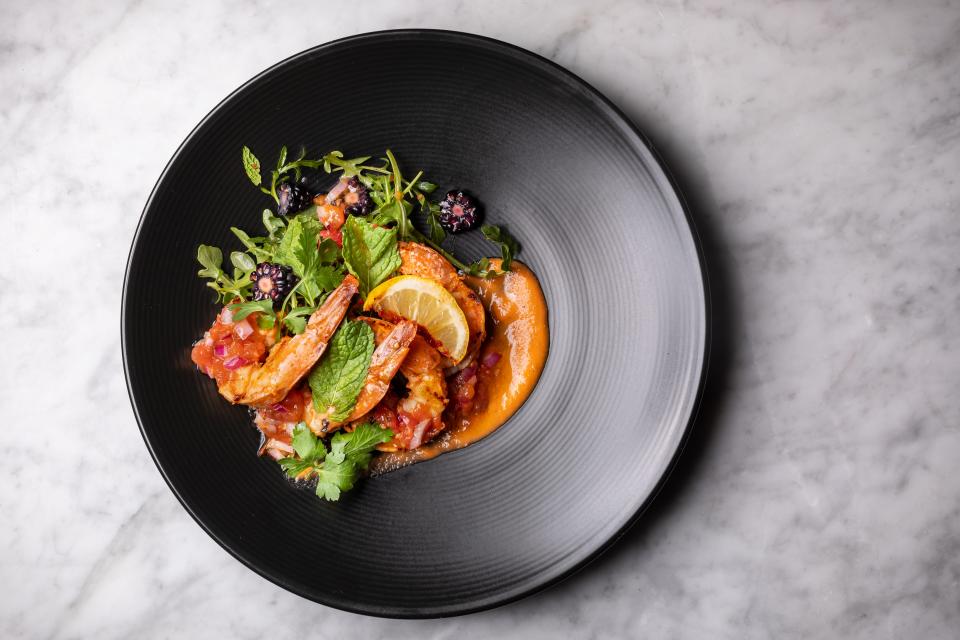
Prep Time: 35 minutes
Total Time: 1 hour
Yield: 4 to 6 servings
1 pound large shrimp, peeled and deveined, tails on
½ cup Piri-Piri marinade, see below
2 cups diced watermelon
1 cup blackberries, cut in half if large
4 cups watercress, arugula, or purslane
½ cup toasted egusi seeds or pepitas
1 cup charred tomato vinaigrette, see below
Salt and freshly ground black pepper, to taste
Toss the shrimp with the marinade and allow to sit for at least 30 minutes.
Prepare a grill pan or large pan over medium-high heat.
Remove the shrimp from the marinade, brushing off any excess. Grill the shrimp until cooked through, about 5 minutes total, rotating once during the grilling process to char nicely on both sides.
Toss the watermelon, blackberries, and greens in a bowl and dress with the vinaigrette, season with salt and pepper.
Transfer the fruit and greens to a platter, top with the shrimp, and sprinkle with toasted egusi or pepitas seeds. Serve immediately.
Piri-Piri Marinade
2 small shallots, peeled
1-inch piece ginger
4 cloves garlic
1 scotch bonnet chili
2 tablespoons lemon juice
2 Tablespoons canola oil
2 teaspoons paprika
1 teaspoon salt
Combine the shallots, ginger, garlic, and scotch bonnet in a food processor, pulse to a coarse puree. Alternatively, pound into a coarse paste using a mortar and pestle. Stir in the lemon juice, oil, and paprika, and season with salt.
Charred tomato vinaigrette
2 large whole heirloom tomatoes
2 tablespoons sherry vinegar
½ teaspoon salt
¼ teaspoon freshly ground black pepper
¼ cup olive oil
½ small red onion
Heat a grill pan or heavy bottom skillet over high heat. Once the pan is sufficiently heated, cook the tomatoes, turning frequently, until nicely charred and blistered all around, 10 to 15 minutes. Remove the charred tomatoes from the heat and when cool enough to handle, roughly chop, reserve any juices for the vinaigrette.
Combine the chopped tomatoes and any tomato juice with sherry vinegar, salt, and pepper. Whisk in the olive oil. Add in the sliced red onion, taste, and adjust seasoning as desired.
Marcus’s Bramble 75 Cocktail Recipe

1.5 oz Bombay Bramble
¾ oz lemon juice
¾ oz honey syrup (3 parts honey to 1-part water)
Top with 4 oz of Martini and Rossi Prosecco
Method: Combine all ingredients except for the prosecco into your cocktail shaker. Give it a quick, hard shake with ice. Strain into your chilled flute and top with 4 oz of prosecco and garnish with a dehydrated blackberry.
Glassware: Flute or coupe glass
Joseph Johnson’s Moroccan Spiced Zucchini and Mushrooms
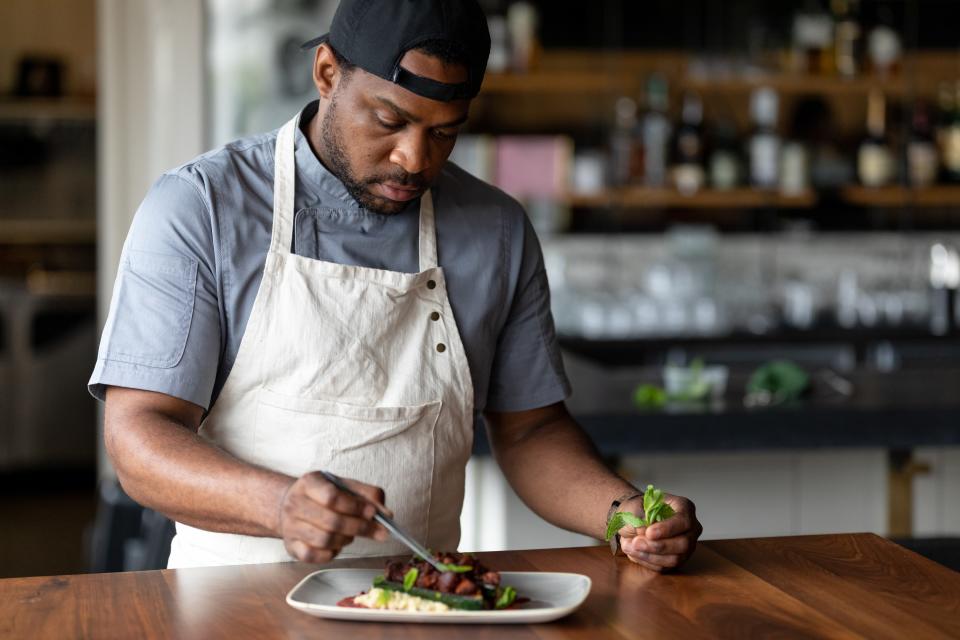
Blackberry Harissa Sauce:
4 chipotle peppers, from can
4 oz jarred roasted red peppers, drained, rinsed, and dried
2 tbsp tomato paste
2 garlic cloves, peeled
1 tsp ground coriander
1 tsp ground cumin
1/2 tsp smoked paprika
1/4 tsp cayenne pepper
1 clamshell (6oz) fresh blackberries
2 tbsp fresh lemon juice
¼ cup extra virgin olive oil
¼ cup water
2tbsp apple cider vinegar
3tbsp honey
Sea salt, to taste
Combine the blackberries, honey, apple cider vinegar, lemon juice, water in a small pot with a lid. Bring to a boil and reduce to a simmer.
Continue to simmer for 5 minutes or until the blackberries are soft. Combine the chipotle peppers with the cooked blackberries and all of the remaining ingredients except for the olive oil.
Transfer to a blender and blend until smooth, stream in the olive oil as you are blending.
Season with sea salt to taste, reserve for further use.
Moroccan Couscous:
3tbsp extra virgin olive oil
1 garlic clove, minced
1tsp dried parsley
1tsp dried basil
1tsp fresh lemon juice
1cup Moroccan couscous
1 ¼ cup chicken stock
Sea salt, to taste
In a medium pot with a lid, heat the 2 tablespoons olive oil over a medium-low flame. Sweat the bell pepper and garlic until tender. Add the chicken stock and lemon juice and bring to a boil. Stir in the couscous and fresh herbs. Remove the couscous from heat and cover with a lid.
Allow couscous to sit for 5 minutes, then remove lid, fluff with a fork, fold in the remaining olive oil and season to taste with sea salt. Reserve warm for further use.
Spiced Zucchini and Mushrooms:
4 medium zucchini, halved length-wise, seeds removed
16 large button or cremini mushrooms, quartered
Sea salt, to taste
Finishing salt, to taste
¼ cup blackberry harissa sauce
1 garlic clove
½ lemon
12 mint leaves, picked
Spice rub, below
Spice Rub:
1 tsp ground cumin
1 tsp ground ginger
1 tsp sea salt
3/4 tsp black pepper
½ tsp ground cinnamon
½ tsp ground coriander
½ tsp cayenne
½ tsp ground allspice
¼ tsp ground cloves
Place a seasoned cast iron or heavy bottom nonstick pan on medium-high heat, and preheat your oven to 400 degrees.
While the pan is preheating, season the zucchini lightly with sea salt and the spice rub, season the mushrooms with only the spice rub, no salt yet. Once the pan is hot, coat with a thin layer of cooking oil, the oil should be lightly smoking. Only cooking 4 pieces of zucchini at a time, place them in the pan cut side down to begin searing for 1-2 minutes. With a spatula remove the zucchini from the pan and place seared side up on an oiled baking tray. Continue this process for the remaining zucchini. Once all of it is seared, place the whole tray in the oven for 5-7 minutes or until the zucchini is cooked to your desired doneness.
While the zucchini is in the oven, add a little more oil to the pan and begin to sauté the mushrooms. Take the garlic clove and stick it on the end of a fork. Use the garlic fork to stir the mushrooms to add a little garlic flavor. Once the mushrooms begin to caramelize in the pan, season lightly with salt and a light squeeze of lemon juice. Adding the salt later allows the mushrooms to caramelize without releasing too much moisture.
Once the mushrooms are well roasted, add the harissa sauce and a little water so the sauce lightly coats the mushrooms, remove from heat until ready to plate.
To plate, with a spoon spread the desired amount of blackberry harissa on the plate. Next, place a mound of couscous towards the center of the plate. On the baking tray fill the zucchini with the cooked mushrooms, then set two pieces of filled zucchini on top of the couscous. Season the whole dish with a little finishing salt, extra virgin olive oil, garnish with basil, and serve.
Adrienne Cheatham’s Marinated Sliced Salmon with Blackberry-Bramble Salsa
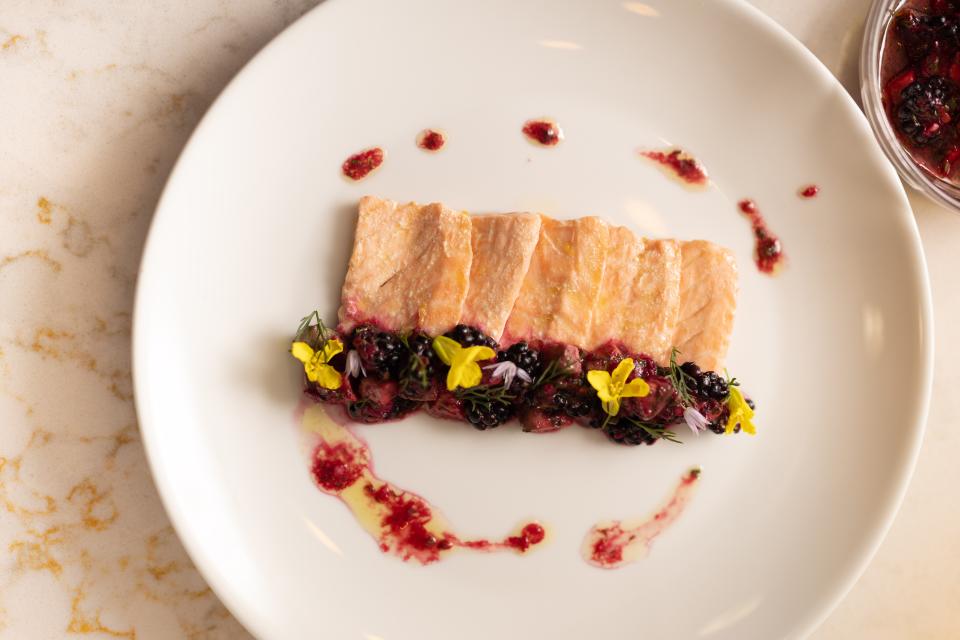
Serves 2-3
1/2lb salmon filet, skin off
2 tbsp extra virgin olive oil
2 tbsp Bombay Bramble + a splash for later
1 lemon
1 small red beet, peeled
1 tbsp minced shallot
1 tsp Dijon mustard
1/2 cup blackberries, cut in half
1 small avocado
2 tbsps freshly chopped dill
Salt and freshly ground black pepper, to taste

Preheat your oven to 350F. Line a baking sheet with parchment paper, rub 1 tablespoon of the evoo over the paper, and sprinkle a pinch of salt over the tray (we’re pretty much seasoning the tray). Slice the salmon filet crosswise into ¼” thick slices and line them up on the prepared tray. Sprinkle a little salt on the top of the slices and set the tray aside.
In a small bowl, combine the Bombay Bramble and the remaining evoo. Use a microplane or grater to zest half of the lemon into the bowl, and stir the zest in (keep the lemon close by, we will use it again). Use a spoon to drizzle the mixture over the salmon slices and place in the oven. Cook the salmon for about 5 minutes, or just until the fish loses the deep pink color and turns translucent. Remove from oven and let cool.
While the salmon cools, cut the lemon in half and squeeze 1 tbsp of juice into a mixing bowl. Use the same grater and grate about 2 tbsps of raw beet into the bowl. Add the minced shallot, Dijon mustard, and halved blackberries. Fold the ingredients to combine, season with a pinch of salt and a good amount of black pepper. Cut the avocado in half, cut the flesh into small squares, and scoop the squares into the bowl. Add the chopped dill, a splash of Bombay Bramble, and gently fold the avocado into the salsa, taste and adjust seasoning (add a pinch of salt, pepper, and/or a squeeze of lemon if needed).
Use a spatula to carefully lift the salmon slices from the tray and arrange on serving plates in a shingled line in the center of each plate. Divide the Blackberry Bramble Salsa among the plates, spooning it directly down the center of each salmon line.
Tristen Epp’s Greek Yogurt Cake Trifle, Raspberry Mousse, Brambleberry Compote
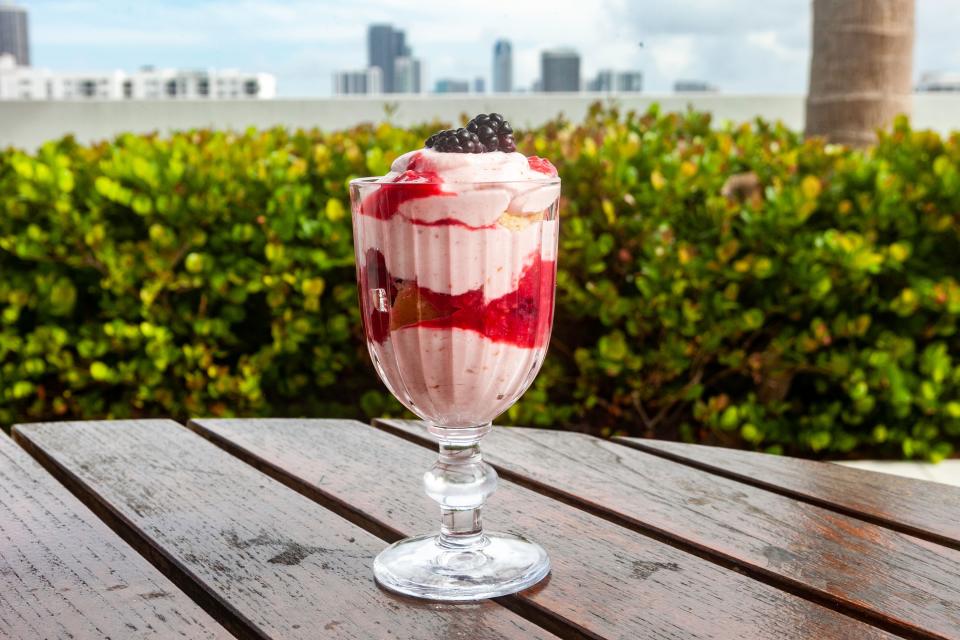
Greek Yogurt Cake
¾ cup Greek yogurt
¾ cups vegetable or olive oil
3 large eggs
1 ⅓ cups granulated sugar
½ tbsp vanilla extract
1 ⅔ cups all-purpose flour, sifted
1 tsp baking powder
⅛ tsp baking soda
Preheat the oven to 350F. Line a quarter tray with parchment paper and non-stick baking spray.
Place all ingredients in a bowl and mix with a wooden spoon until smooth.
Pour into the prepared baking sheet and bake for 15 minutes. Allow to cool to room temperature before cutting into small pieces for the trifle.
Raspberry Mousse
4 cups raspberries, pureed in food processor and sieved
2 ½ tsp powdered gelatin
1 cup confectioner’s sugar
2 cups heavy cream
Bloom gelatin in ¼ cup cold water. Set aside.
Heat raspberry puree and sugar until it is simmering. Remove from heat and stir in gelatin until dissolved. Cool to room temperature using an ice bath.
In a stand mixer fitted with a whisk attachment, whip heavy cream to soft peaks. Fold the whipped cream into the raspberry mixture. Transfer to the fridge to firm up.
Compote
½ inch piece of ginger
4 cups raspberries, pureed in food processor and sieved
3 cups blackberries, cut in half
1 tsp lemon juice
¼ cup Bombay Bramble
1 cup granulated sugar
Peel and grate ginger with a microplane. Combine all the ingredients except the blackberries in a pan and bring to a boil.
Once simmering, gently fold in blackberries. Cover the pan and cook for 5 minutes. Remove from heat, transfer to a bowl, and chill in an ice bath.
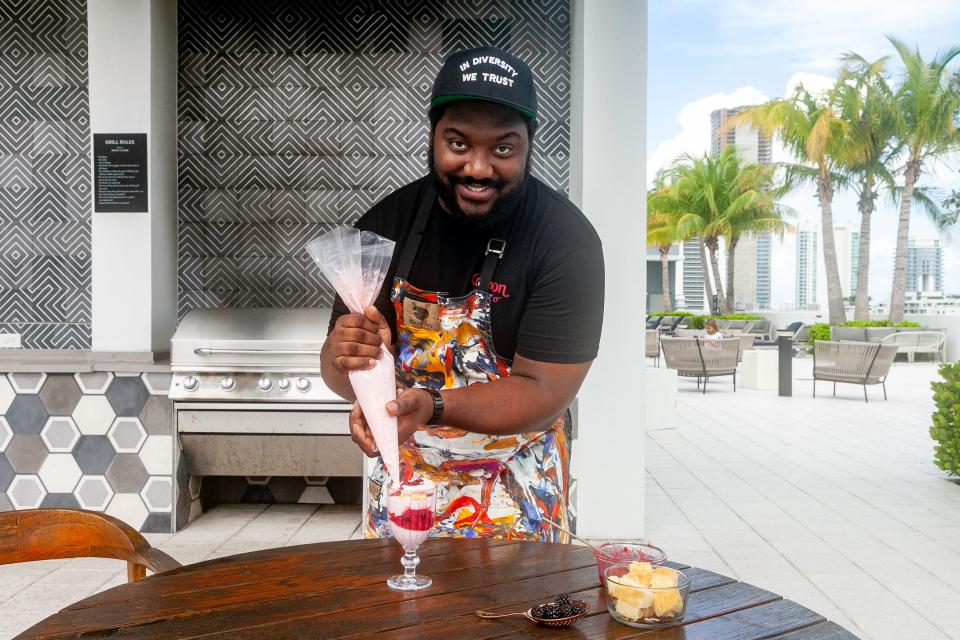
To assemble:
Greek Yogurt Cake, cut into pieces
Brambleberry Compote
Raspberry Mousse
Crystallized ginger, diced—to taste
In small ramekins or a trifle dish, place a layer of Greek yogurt cake pieces on the bottom. Next, even cover with the compote followed by the mousse. Sprinkle chopped crystallized ginger on top of mousse and repeat the layering process until the ramekins or trifle dish is full.
Originally Appeared on Vogue

